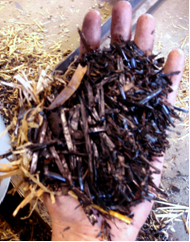What is torrefaction?
Torrefaction is the mild thermal treatment of biomass, or more generally, of organic by-products. The process modifies a number of the material's properties in such a way that it can be used as an environmentally friendly fuel in homes and industries.

The characteristics of torrefaction:
- Torrefaction takes place at temperatures between 250 and 350 °C. The process lasts about 30 minutes and does not burn the material.
- Torrefaction can be used for all organic by-products that, preferably, contain as little water as possible. By-products with a high water content can be treated, but a lot of the heat is lost in the subsequent drying process.
- The properties for thermal conversion, which can be very different for each of the unprocessed fuels, become more and more similar during the process resulting in the homogenisation of the different by-products.
- The material becomes hydrophobic, i.e. water repellent, meaning that it can be stored for a long time without disintegrating.
- Depending on the torrefaction circumstances, the material becomes brittle and is easy to grind into powder with little energy. The latter is significant for co-firing in powder coal heaters.
- Because of the evaporation of the organic components, the material loses some 30% of its weight while the incineration value only decreases by 10%.
- The evaporated gas has a net incineration value that, depending on the input's water content, can be high enough to provide enough thermal energy for the process.
- The torrefacted product can be pressed into pellets to create a fuel with homogenous feeding and conversion properties. Pressing it into pellets makes it easy and safe to transport. Today's pellet furnaces have automatic feeding systems that are still based on sawdust and wood chips. The market for this product will grow providing torrefacted material can be made into pellets with properties that are similar to the current product.
This project was supported by the European Agricultural Fund for Rural Development.
